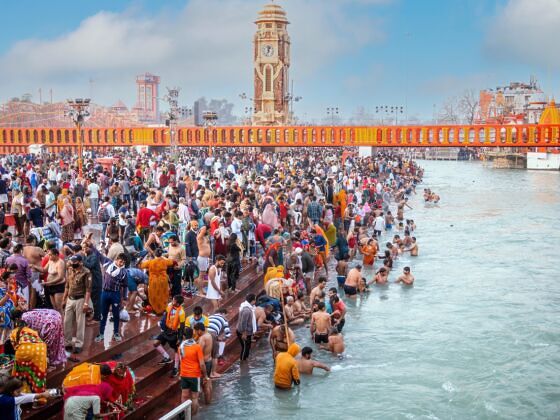Think of your school assembly. I remember 1,000 floppy blood-red hats rolling out in front of me towards the feet of the headmaster’s morally charged parables. I can picture a stadium full of people, no fewer than 50,000 miniature faces on the other side of a football pitch. It’s as hypnotising as the game itself.

I inflate that number to a million people marching, placards in hand, in peaceful protest against the war in Iraq. London was heaving with people, as all central roads became crowded pathways.
In a few days’ time, the city of Allahabad will struggle to reveal a patch of bare earth to the sky above. The largest gathering of people on the planet for a sole purpose will envelop the city and immerse itself in the converging rivers.
Kumbh Mela is the most popular and sacred Hindu pilgrimage. Small (comparatively) installments of it happen every 3 years with the Ardh (half) Kumbh Mela happening every 6 years and the Purna (full) Kumbh Mela taking place every 12. The last Purna Kumbh Mela happened in 2001, and the estimated numbers fluctuate between 50 and 70 million visitors over the course of the festival.
This year, the main dates fall between the 27th of January and the 25th of February. Pilgrims will flock to drain their sins into the Ganges, Yamuna, and Sarasvati Rivers. There are several important bathing dates, and it has been widely claimed that on one of these dates, in 2001, at least 30 million people were in the city. This means Allahabad became the most populous city in the world at that time.
If the entire populations of London, New York, and Tokyo had gathered on that day, they would’ve still fallen a few million short of the numbers at Kumbh Mela.
At the last Ardh (half) Kumbh Mela in 2007, an estimated 70 million people attended. Events organisers with the resurrected lineup of Bob Marley, Amy Winehouse, and Frank Sinatra would struggle to pull such a crush of fans. Dread-locked sadhus draped in saffron, their skin daubed with ash and powder, have been trickling into the city in preparation for the last few months.
Tent cities are being erected and guesstimates as to the number of people expected to make the journey this year mushroom to as high as 100 million. Here are some festive facts:
- 56.2km of temporary road has been built.
- 18 pontoon bridges have been erected on the rivers.
- There will be 35,000 toilet seats.
- 25,800 metric tonnes of food will be distributed.
The mythology behind the pilgrimage seems to contain a similar number of individuals as this year’s festival estimations indicate. As much as I would like to I just don’t feel I could capture the same energy, or cram its characters into such a celestial huddle, in the way that the author of this summary on www.kumbhvillage.com managed to:
Once upon a time sage Durvasa (spiritually enlightened sage) visited Amravati, the capital of Swarga (heaven). The sage in pleasant mood intended to see Lord Indra and on meeting him affectionately offered garland of ‘never wilting flowers’. Lord Indra took them in a casual way and passed the garland to Airawat (divine elephant) who in turn crushed the garland under its feet. Angered at Lord Indra’s arrogance, Sage Durvasa pronounced a curse on him, devoiding him of all the riches, virtues and power. Knowing this, demon king Bali attacked Lord Indra and snatched away all the riches and virtuous possessions. The gods were weakened and then Lord Vishnu (the preserver of the Universe) advised Lord Indra that to regain his lost powers and splendour he needed ambrosia or Amrita (divine nectar). To extract this from the depths of the ocean, the demons were motivated to churn the ocean along with the gods. Mighty mountain Mandarachal was used as churn staff, formidable serpent king Vasuki became the string to move the churn, Lord Vishnu in the guise of koorm (tortoise) gave support from the bottom and Lord Brahma (the creator of Universe) guided the churning from top.
With the churning, fourteen Ratnas (virtuous jewels) emerged from the ocean. These were Poison, Flying Horse, Magic Moon, Sky chariot, Vibrant Lyre, Rambha (the siren), Lakshmi (the paragaon of beauty and the provider of all riches), Vishwakarma (the divine architect), Dhanvantari (the divine healer), Gajaraj (the divine elephant), Kaustubh Mani, the divine conch shell, Varuni (the enchantress) and the coveted kumbh (pitcher) of Amrit (divine nectar).
With the emergence of amrit, there was scramble amongst the gods and demons for the possession of the divine elixir. Lord Vishnu handed over the kumbh (pitcher) of amrit to divine Garuda (the winged mount of Lord Vishnu). Garuda, who was to take the pitcher of nectar safely to heaven (Swarga), was stopped on way at four places by the demons. These places are the present day Allahabad, Hardwar, Ujjain and Nashik, where Garuda had to put the pitcher down. Some of the nectar spilled at these places, sanctifying them forever. (As per Skand Puran, the story of taking away the pitcher by Jayanta, son of Lord Indra and the episode of spilling of nectar is mentioned, while other Purans — Vishnu, Brahamandu , Padma, Bhagwat , Agni, Mahabharat and Ramayana narrate the story of Garuda the winged mount of Lord Vishnu).
All along the flight, Garuda was guided by Lord Brihasapati (Jupiter), then transiting in the rashi (zodiac) Acquarius, Taurus and Leo. Sun and Saturn along with the Moon were on the vanguard in protecting the Amrit Kumbh (pitcher of divine nectar). The flight of Garuda lasted 12 days (12 human years). Therefore Kumbh is celebrated around every twelve years.